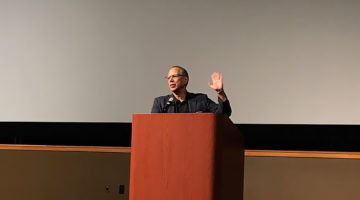“S-Town” is the newest podcast series from “This American Life” and “Serial.” The series was released in a seven-chapter format simultaneously last month, and it’s reached a wide audience, even outdoing its predecessor “Serial.” Along with popularity came many critics who have brought up serious ethical questions concerning how the story was reported and whether it should have been reported at all.
There’s no denying the skill and professionalism of the investigative journalists at “This American Life.” Sarah Koenig from “Serial” and now Brian Reed, the reporter and narrator behind “S-Town,” are masterful storytellers. But, this brand of journalism – if we can or should call it that – is still relatively new, and listeners and critics are struggling to figure out what to make of it in relation to other media.
“S-Town” goes from murder mystery to treasure hunt to family feud to, finally, a character study of some sort of twisted genius. Reed began researching the story in 2013 after John B. McLemore, a native of Woodstock, Alabama, sent him an email about an unsolved murder in his “shit” town, riddled with corruption and cover-ups.
Reed traveled from New York to the small Alabama town many times throughout his investigation, which spans roughly three years, and he became enthralled by McLemore, his friends and the citizens of “Shit Town.”
Throughout the narrative, Reed’s research became less about the murder mystery and more about the people surrounding it, especially McLemore, an eccentric clockmaker, climate change activist and self-proclaimed outsider who is considered a certifiable genius by many people who know him.
Critics say Reed became personally involved with the subjects of his story to the extent that he becomes a character in the story himself. Gay Alcorn wrote for The Guardian that Reed’s involvement diminishes the integrity of the reporting.
“The failure of Reed and [This American Life] is that they never mounted the defense, never explained to their listeners why they made the choices they made, even whether they found them difficult or easy decisions,” Alcorn wrote. “They assume with a degree of arrogance that this is Reed’s story, not McLemore’s, whose agonies are laid out for our voyeuristic entertainment. Not in a cheap, tabloid TV way, but in a sophisticated, subtle way.”
Reed does seem to be the star of the show. The most emotional (and sometimes awkward) sequences in “S-Town” stem from his conversations with the characters he became close with. In a similar way, Koenig is what made “Serial” so popular. Her dedication to finding the truth and her deep conversations with Adnon Syed and Bowe Burgdahl, who are both possibly sociopaths (which Koenig acknowledges), are what makes the series so great.
Reed believes becoming a character is part of the job in his medium. He told the Pacific Standard, “In radio, the most alive tape, and the tape you’re going to most often, is the tape where you as the reporter are interacting with the people you’re talking to. That, by its very nature, makes a reporter in a radio story more of a character, maybe.”
I agree with Reed that radio is a different type of reporting. It’s more personal, and the story comes out in the heat of the moment, as a conversation is happening, whereas a writer has the opportunity to find it later in a more detached environment.
However, if we are going to accept that these podcast reporters insert themselves into their stories and live outside the law of journalism in a sense, then we all need to acknowledge that podcasts don’t belong to the same mold as standard reporting. They aren’t straight news. They are something different.
While I don’t find Reed’s reporting on “S-Town” to be ethically reprehensible, I do believe there need to be some new guidelines for the way these podcasts are created and marketed. Both “S-Town” and “Serial” toe the line between journalism and entertainment, sort-of like documentary films. But the difference is documentaries are understood to be purposefully persuasive whether subtly (The Thin Blue Line) or sometimes not so subtly (Blackfish).
“S-Town” and “Serial” are constantly manipulating the listener’s perception of characters and events as they unfold throughout their narratives. I was (and still am) in a continuous flux between believing Adnon was the murderer and believing he was innocent because that’s the way Koenig wants me to be. And, I trust her. Throughout the first half of “S-Town” I was all team Tyler, and then Reed finally remembered to tell us the cousins’ side of the story in a classic bait and switch move. He says he told the story chronologically, but we all know he was just being dramatic.
Somewhere within “S-Town” and “Serial” are all the facts and whether these reporters presented them appropriately is for you to decide. Further, these stories are about real events and real people. They aren’t entertainment, and the public’s hunger for a juicy narrative is no excuse for a reporter to spin them that way.












